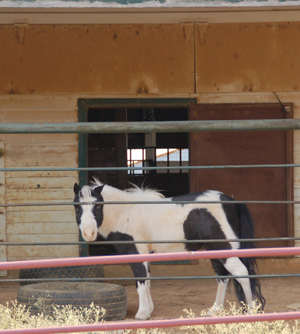 Hi Stacy, I recently purchased your CD’s in preparation to work with my new 5 year old. She has had some ground work but has not been worked with in over a year. Is a fairly quite Mare that is super smart. I have had her about one month now and have been working with her daily for about 3 weeks now. I have noticed in her stall and in the paddock while she is eating hay if I attempt to rub or touch her rear she will strike out alittle. I know this should not be happening. What is the best way to put an end to it. Thank you so much for your spirit, love of animals and making your training available to all. Sincerely, Lynn from Mass
Hi Stacy, I recently purchased your CD’s in preparation to work with my new 5 year old. She has had some ground work but has not been worked with in over a year. Is a fairly quite Mare that is super smart. I have had her about one month now and have been working with her daily for about 3 weeks now. I have noticed in her stall and in the paddock while she is eating hay if I attempt to rub or touch her rear she will strike out alittle. I know this should not be happening. What is the best way to put an end to it. Thank you so much for your spirit, love of animals and making your training available to all. Sincerely, Lynn from Mass
1 Comments
Leave a Comment

FREE PDF DOWNLOAD
WHY IS MY HORSE...?
100% Private - 0% Spam
No one taught you the skills you need to work through these things.
Riders often encounter self-doubt, fear, anxiety, frustration, and other challenging emotions at the barn. The emotions coursing through your body can add clarity, or can make your cues indistinguishable for your horse.
Learning these skills and begin communicating clearly with your horse.
Click here to learn more.

I have heard people say to this type of problem, just don’t bother them while they are eating. Sometimes they have to be bothered when eating. If you don’t correct the problem, it could become a dangerous situation that could eventually escalate when you go to feed. I had a horse once that wasn’t weaned from his dam until we bought him at a little over 2 years old. To make matters worse, he was stalled and fed with her at feeding time as well. The first time I fed him he attacked me. We’re talking ears back, lunging forward, pawing, attacking. I had to get a stick to keep him off me so I could get his hay in his feeder. I had to drive him away from his feed and WOULD NOT let him come back to it until the aggressiveness in his body and head was gone. It took 2 days for him to respect and trust that I was not going to fight him for the food, I was the one supplying it and the only way he was going to get it was to behave. He did well with me after that, but then did it to my son and I had to show my son what to do. Then we sent him to be trained and about a week after being at the trainers, he attacked the trainer out of the blue. The trainer had a bucket in his hand and bonked him on the head with it. He didn’t go after him after that. When we sold him, he was food aggressive to the new owners as well. Once he learned his place at feeding time, he was good. I have a filly now, going on 4, that I have never had a problem with. All of a sudden, last week, she pinned her ears at me and swung her head at me when I went to pat her after giving her her hay. This is something I have done for years. We have had her since birth. I thought maybe it was a fluke. I did it again, and so did she. So, like the gelding, I drove her from her feed, altho I didn’t have to use a stick! I wouldn’t let her come back to it until she kept her ears forward and was completely stopped and waiting for permission. I let her come back and touched her again and she put her ears back and tilted her head. I drove her away again. The 3rd time she was fine. That evening I patted her like always, she almost put her ears back, but thought better of it. Since that one incidence, she is back to normal. I believe had I not handled the situation right away, it would just have gotten worse. I also believe the horse needs to be tollerant to any situation at any given time. It makes for a safer environment.